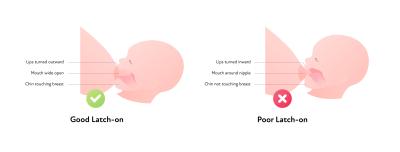ABCs And 123s To Latching Well

Latching well at the breast is a key component to a successful breastfeeding experience. Not only will a good latch result in better transfer of milk for your baby, it will also be more comfortable for you. Latching well can take time, practice, and patience. It may be helpful to remember the “ABCs and 123s to latching well”. If you try these steps and are still having difficulty latching well, please reach out to us for support. We have a team of Board-Certified Lactation Consultants on staff and are ready to help!
A – Asymmetrical latch – Position your baby’s mouth off-center of the nipple so that more of your lower areola is in your baby’s mouth. Lining up your nipple to your baby’s nose may help.
B– Bring baby to breast – Remember to bring your baby to breast versus your breast down to baby. Nursing/supportive pillows may help. Position your baby so that his/her belly is facing your belly.

C– Compress your breast – Position your hand with a “C” shape around your breast. The “C-hold” of the breast will help shape your breast like a sandwich for your baby. Make sure your fingers are away from your nipple and areola so that your baby can latch deeply to the breast.
1 - Observe for early hunger cues - It is easier to latch your baby when your baby is not overly hungry and crying. Early hunger cues such as stirring, mouth opening, and turning head or rooting are good times to initiate latching your baby. If your baby has reached a late-stage hunger cue and is crying, it is good to calm your baby with skin to skin or rocking and attempt again when your baby is calm.
2 – Help your baby open wide - Use your nipple to stroke from your baby’s nose to upper lip until your baby opens very wide. Your baby’s chin should come into your breast first below the lower portion of your areola. With gentle support behind your baby’s neck, help move your baby into your breast.
3 – Observe for signs of a good latch - Your baby should have a wide-open mouth, chin touching breast, lips flanged outward and you should not be in pain.
If you are having trouble or have questions about breastfeeding, talk with your provider at your next visit. If you need more support in your breastfeeding journey, Annapolis Pediatrics has International Board Certified Lactation Consultants on-staff to help you. Call us to make an appointment with one of our Lactation Consultants.
